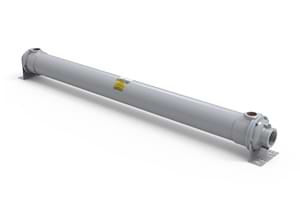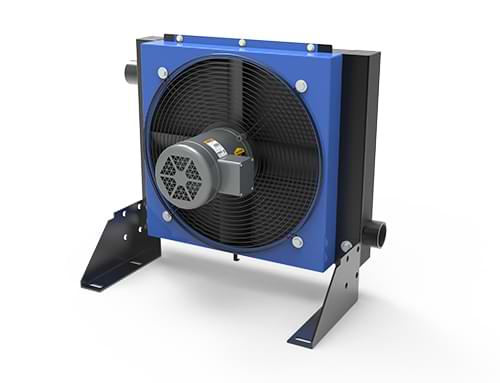Aftercoolers for Soda Blasting
Introduced as a gentler alternative to traditional methods like sandblasting, soda blasting employs compressed air to propel the sodium bicarbonate particles at high velocity onto a surface. The process effectively removes contaminants such as rust, paint, grease, and grime without causing significant damage to the underlying material. Its non-toxic, water-soluble nature makes it an appealing choice for industries seeking sustainable solutions.
Applications
- Gentle Cleaning: Soda blasting uses sodium bicarbonate to remove paint and rust without damaging delicate surfaces like metal or glass. Aftercoolers ensure dry air, preventing soda from clumping, which maintains consistent flow and effectiveness during the process.
- Versatile Applications: From automotive restoration to graffiti removal, soda blasting adapts to various industries. Aftercoolers cool compressed air, removing moisture that could corrode equipment or surfaces, ensuring precision and reliability across diverse tasks.
- Equipment Longevity: Soda blasting’s eco-friendly approach relies on well-maintained air systems. Aftercoolers reduce heat and humidity, minimizing wear on compressors and tools, extending their lifespan, and lowering maintenance costs in continuous-use settings.
Water Cooled Aftercoolers
Compressor Cooling
- Fixed or Removable Tube Bundles
- Material Options Available
- Standard and Custom Options

Air Cooled Aftercoolers
Compressor Cooling
- Use Ambient Air to Cool
- Variety of Motor Options
- Standard Pressures of Up To 250 psi

The applications of soda blasting are vast and span multiple sectors. In automotive restoration, it’s widely used to strip paint and rust from car bodies, leaving metal surfaces intact and free of warping—a common issue with harsher abrasives. Similarly, in marine maintenance, soda blasting cleans boat hulls of algae, barnacles, and old coatings without damaging fiberglass or aluminum. The construction industry employs it to remove graffiti from brick or stone walls, preserving the structural integrity of historic buildings. It’s also valuable in industrial settings for degreasing machinery and in food processing plants where non-toxic cleaning is paramount. Even in aerospace, soda blasting delicately cleans precision components without altering their dimensions.
- Automotive Restoration: Strips paint and rust from car bodies without warping metal surfaces, unlike harsher abrasives.
- Marine Maintenance: Cleans boat hulls of algae, barnacles, and old coatings while preserving fiberglass and aluminum.
- Construction: Removes graffiti from brick or stone, maintaining the integrity of historic structures.
- Industrial Settings: Degreases machinery efficiently, ideal for heavy-duty environments.
- Food Processing: Provides non-toxic cleaning, meeting strict safety standards.
- Aerospace: Gently cleans precision components without altering their dimensions.
What sets soda blasting apart is its versatility and gentleness. Unlike sand or glass bead blasting, which can etch or pit surfaces, sodium bicarbonate fractures upon impact, dissipating energy and minimizing substrate damage. This makes it suitable for delicate materials like glass, chrome, or thin metals. Additionally, cleanup is straightforward—since baking soda dissolves in water, residue can often be rinsed away, reducing waste disposal concerns. However, the process requires careful control of compressed air systems to ensure consistent performance, which is where equipment like aftercoolers becomes critical.
Compressed air aftercoolers are essential in soda blasting setups because they manage the temperature and moisture content of the air used to propel the soda. When air is compressed, it heats up and retains moisture from the atmosphere. Without cooling, this hot, humid air can cause the sodium bicarbonate to clump, clogging nozzles and reducing blasting efficiency. Aftercoolers lower the air temperature immediately after compression, condensing water vapor into liquid form, which is then removed via a separator. This results in dry, cool air that ensures the soda remains free-flowing and effective.
The importance of aftercoolers extends beyond preventing clogs. Moist air can introduce corrosion to the blasting equipment or the surface being cleaned, especially in metal applications. Dry air also enhances the precision of the blast, maintaining a uniform stream and reducing downtime for maintenance. In environments where soda blasting is used continuously, such as industrial facilities, an aftercooler can significantly extend the lifespan of compressors and blasting tools by reducing wear from heat and moisture.


